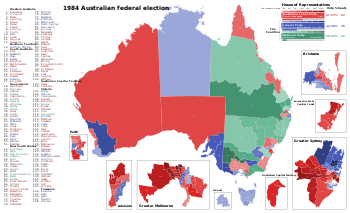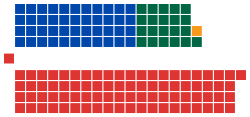
1984 Australian federal election

| |||||||||||||||||||||||||||||||||||||||||||
All 148 seats in the House of Representatives 75 seats were needed for a majority in the House 46 (of the 76) seats in the Senate | |||||||||||||||||||||||||||||||||||||||||||
|---|---|---|---|---|---|---|---|---|---|---|---|---|---|---|---|---|---|---|---|---|---|---|---|---|---|---|---|---|---|---|---|---|---|---|---|---|---|---|---|---|---|---|---|
| Registered | 9,869,217 | ||||||||||||||||||||||||||||||||||||||||||
| Turnout | 9,295,421 (94.19%) ( | ||||||||||||||||||||||||||||||||||||||||||
| |||||||||||||||||||||||||||||||||||||||||||
 Results by division for the House of Representatives, shaded by winning party's margin of victory. | |||||||||||||||||||||||||||||||||||||||||||
| |||||||||||||||||||||||||||||||||||||||||||
1984 Australian federal election |
|---|
| National results |
| State and territory results |
|
|
The 1984 Australian federal election was held in Australia on 1 December 1984. All 148 seats in the House of Representatives (24 of them newly created) and 46 of 76 seats in the Senate (12 of them newly created) were up for election. The incumbent Labor Party led by Prime Minister Bob Hawke defeated the opposition Liberal–National coalition, led by Andrew Peacock.[1]

The election was held in conjunction with two referendum questions, neither of which was carried.

Background and issues
The election had a long campaign and a high rate of informal voting for the House of Representatives, but decreased rate in the Senate (due to the introduction of the Group voting ticket). Although a House election was not due until 1986, Hawke opted to call an election 18 months early in part to bring the elections for the House and Senate back into line following the double dissolution election of 1983.

The legislated increase in the size of the House by 24 seats and the Senate by 12 seats came into effect at the 1984 election. Prior to 1984 the electoral commission did not undertake a full distribution of preferences for statistical purposes. The stored ballot papers for the previous election were put through this process prior to their destruction – therefore the figures from 1983 onwards show the actual result based on full distribution of preferences.

Results
House of Representatives

Labor (82)
Opposition (66)
Coalition
Liberal (44)
National (21)
CLP (1)
| Party | Votes | % | Swing | Seats | Change | ||
|---|---|---|---|---|---|---|---|
| Labor | 4,120,130 | 47.55 | −1.93 | 82 | |||
| Liberal | 2,951,556 | 34.06 | −0.06 | 44 | |||
| National | 921,151 | 10.63 | +1.42 | 21 | |||
| Country Liberal | 27,335 | 0.32 | +0.08 | 1 | |||
| Liberal/National Coalition | 3,900,042 | 45.01 | +1.40 | 66 | |||
| Democrats | 472,204 | 5.45 | +0.42 | ||||
| Others | 172,576 | 1.99 | |||||
| Total | 8,664,952 | 148 | |||||
| Two-party-preferred | |||||||
| Labor | 4,484,622 | 51.77 | −1.46 | 82 | |||
| Liberal–National coalition | 4,178,572 | 48.23 | +1.46 | 66 | |||
| Invalid/blank votes | 630,469 | 6.8 | +4.7 | ||||
| Turnout | 9,295,421 | 94.2 | |||||
| Registered voters | 9,869,217 | ||||||
| Source: Federal Election Results 1949-1993 | |||||||
Senate

Labor (34)
Opposition (33)
Coalition
Liberal (27)
National (5)
CLP (1)
Crossbench (9)
Democrats (7)
NDP (1)
Independent (1)

| ||||||||
|---|---|---|---|---|---|---|---|---|
| Party | Votes | % | Swing | Seats won | Total seats | Change | ||
| Australian Labor Party | 3,750,789 | 42.17 | −3.32 | 20 | 34 | |||
| Liberal/National joint ticket | 1,130,601 | 12.71 | −11.49 | 3 | * | * | ||
| Liberal Party of Australia | 1,831,006 | 20.59 | +8.58 | 14 | 27 | |||
| National Party of Australia | 527,278 | 5.93 | +0.87 | 2 | 5 | |||
| Country Liberal Party | 27,972 | 0.31 | +0.04 | 1 | 1 | |||
| Liberal/National Coalition | 3,516,857 | 39.54 | –0.41 | 20 | 33 | |||
| Australian Democrats | 677,970 | 7.62 | −2.32 | 5 | 7 | |||
| Nuclear Disarmament Party | 643,061 | 7.23 | * | 1 | 1 | |||
| Harradine Group | 22,992 | 0.26 | −0.32 | 1 | ||||
| Others | 282,431 | 3.18 | +0.73 | |||||
| Total | 8,894,100 | 46 | 76 | |||||
| Invalid/blank votes | 437,065 | 4.7 | –5.2 | |||||
| Turnout | 9,331,165 | 94.5 | ||||||
| Registered voters | 9,869,217 | |||||||
| Source: Federal Election Results 1949-1993 | ||||||||
Seats changing hands
| Seat | Pre-1984 | Swing | Post-1984 | ||||||
|---|---|---|---|---|---|---|---|---|---|
| Party | Member | Margin | Margin | Member | Party | ||||
| Farrer, NSW | Liberal | Wal Fife | 7.4 | N/A | 12.95 | Tim Fischer | National | ||
| Flinders, Vic | Labor | Bob Chynoweth | 0.3 | 1.47 | 1.17 | Peter Reith | Liberal | ||
| Forde, Qld | Labor | notional – new seat | 2.7 | 2.74 | 0.04 | David Watson | Liberal | ||
| Gilmore, NSW | Labor | notional – new seat | 0.5 | 1.72 | 1.22 | John Sharp | National | ||
| Hinkler, Qld | Labor | notional – new seat | 0.6 | 0.79 | 0.19 | Bryan Conquest | National | ||
| Hume, NSW | National | Stephen Lusher | 4.3 | N/A | 7.65 | Wal Fife | Liberal | ||
| Macquarie, NSW | Labor | Ross Free | 0.5 | 1.89 | 1.39 | Alasdair Webster | Liberal | ||
| Northern Territory, NT | Labor | John Reeves | 1.9 | 3.29 | 1.39 | Paul Everingham | Country Liberal | ||
| Petrie, Qld | Labor | Dean Wells | 1.5 | 2.13 | 0.63 | John Hodges | Liberal | ||
| Riverina-Darling, NSW | Labor | notional – new seat | 1.3 | 5.90 | 4.60 | Noel Hicks | National | ||
- Members listed in italics did not contest their seat at this election.
Analysis

The results of the election surprised most analysts;[citation needed] the expectation had been that Bob Hawke – who had been polling a record ACNielsen approval rating of 75 percent[2] on the eve of the election – would win by a significantly larger margin. Labor instead suffered a 2-point swing against it and had its majority cut from 25 to 16. Hawke blamed the result on the changes to Senate vote cards, which he believed confused people regarding their House of Representatives votes and contributed to the relatively high informal vote, the majority of which apparently was Labor votes.[3] However, analysis by the Australian Electoral Commission found that informal voting only slightly reduced Labor's primary vote and did not change the result in any division.[4]

Andrew Peacock did well from a good performance in the one leaders' debate, held on 26 November 1984,[5] which was the first televised leaders' debate in Australia.[6] It was because of Peacock's performance at the leaders' debate that Hawke refused to debate John Howard for the 1987 election. Ironically when Hawke agreed to do the leaders' debate for the 1990 election it was again with Peacock.

See also
- Candidates of the 1984 Australian federal election
- Members of the Australian House of Representatives, 1984-1987
- Members of the Australian Senate, 1985-1987
References
- ^ Maley, Michael (1985). "The Australian general election of 1984". Electoral Studies. 4 (1): 69–71. doi:10.1016/0261-3794(85)90032-0. ISSN 0261-3794.
- ^ Coorey, Phil (20 May 2008). "The biggest hammering in history". The Sydney Morning Herald. Retrieved 20 May 2008.
- ^ Hawke, RJL (1996). The Hawke Memoirs. Port Melbourne: Mandarin. pp. 275–276. "Attracted to the simplicity of the Senate ballot, a number of voters thought they could mark their Lower House ballot in exactly the same way. Unfortunately for both them and us the informal vote for the House of Representatives swelled from 2 per cent to nearly 7 per cent. On the best surmise the bulk of the informals were Labor votes."
- ^ Green, Antony (11 January 2013). "Past Research on the Intended Party Vote of Informal Ballot Papers". ABC News. Retrieved 23 July 2023.
- ^ Fraser, Bryce (1998). The Macquarie Reference Series: Government in Australia. Sydney: The Macquarie Library Pty Ltd. p. 44. ISBN 1-876429-02-X.
- ^ "1984 Federal Election". AustralianPolitics.com. Retrieved 30 July 2016.
External links
- University of WA Archived 18 January 2015 at the Wayback Machine election results in Australia since 1890
- AEC 2PP vote
- AustralianPolitics.com election details
See what we do next...
OR
By submitting your email or phone number, you're giving mschf permission to send you email and/or recurring marketing texts. Data rates may apply. Text stop to cancel, help for help.
Success: You're subscribed now !



